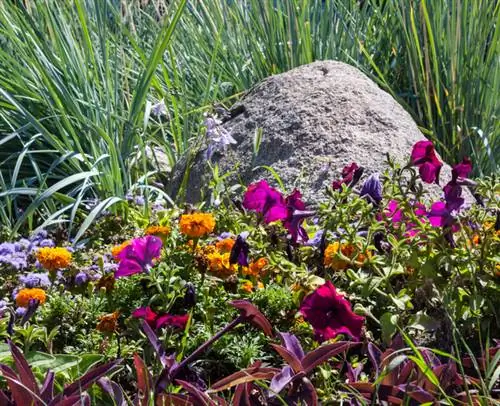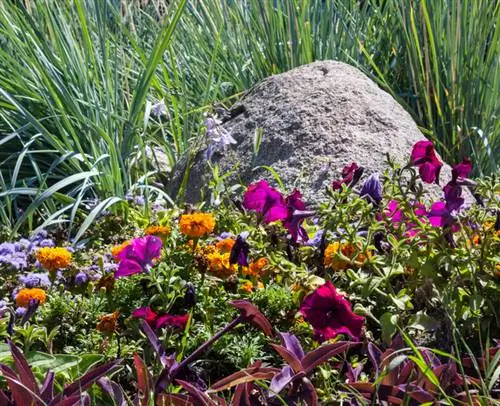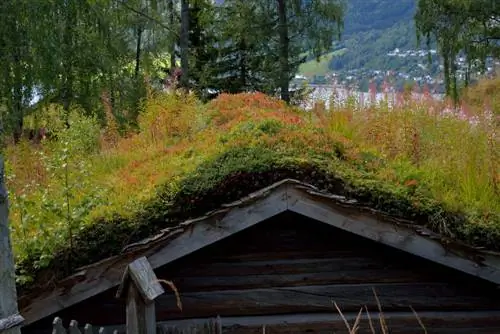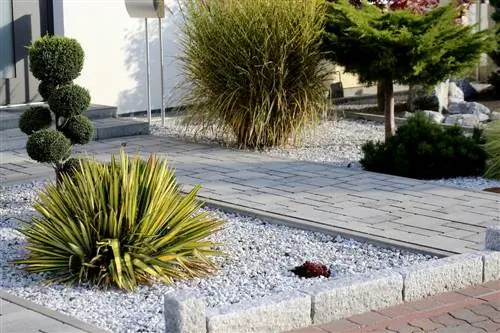- Author admin [email protected].
- Public 2023-12-16 16:46.
- Last modified 2025-01-23 11:21.
A rock garden looks natural and authentic especially when the planting offers variety. In addition, many of the cushion plants only bloom in spring or early summer, so bright green, blue or brightly colored grasses - which sometimes stay green all year round - offer an interesting eye-catcher. Almost all grasses form dense clumps; where some remain low, but others can become quite high.

Which grasses are suitable for a rock garden?
Popular grasses for rock gardens include mosquito grass (Bouteloua gracilis), Monte Baldo sedge (Carex baldensis), red sedge (Carex buchananii), mountain sedge (Carex montana), blue fescue (Festuca cinerea) and bearskin grass (Festuca gautieri). These grasses prefer sunny, dry locations and offer variety as well as attractive colors and structures in the rock garden.
Mosquito grass (Bouteloua gracilis)
This is a typical prairie grass, whose gray-green leaf tufts that grow up to 30 centimeters high form horizontally protruding spikes. The eye-catching flowers appear between July and August. The plant loves sunny and dry locations and feels particularly comfortable on rubble and in rock crevices. Be careful when planning the rock garden, because the mosquito grass does not tolerate lime and therefore also does not tolerate calcareous stones such as tuff.
Monte Baldo sedge (Carex baldensis)
The striking and very beautiful Monte Baldo sedge forms dark green leaf clusters that grow up to 20 centimeters high. The snow-white flowers can be seen between June and July. This type of grass is best cultivated in limestone scree and crevices and should not be too dry. A sunny location is an absolute must.
Fox red sedge (Carex buchananii)
This beautifully brown-red colored grass, up to 40 centimeters high, grows in dense clumps with thin, upright stalks. Like other sedges, the fox red sedge prefers a sunny and not too dry location. It grows particularly well between scree and in crevices, but it should not be planted on limestone. This sedge also looks very pretty when planted in troughs. In winter you should ensure good protection against moisture.
Mountain sedge (Carex montana)
This delicate grass, which only grows to a height of around 10 centimeters, blooms unusually early: the delicate flowers can be seen as early as March and April. Otherwise, the mountain sedge grows in dense clumps of leaves and has slender, light green leaves. In contrast to the fox-red sedge, the mountain sedge feels very comfortable in limestone rock, but also prefers to grow on scree and in crevices. Choose a sunny and not too dry location.
Blue fescue (Festuca cinerea)
The blue fescue grass, which grows to a height of up to 20 centimeters, is striking due to its very thin, gray-blue tufts of leaves. These grow in dense clumps and produce flowers from June to July. The two rather small varieties 'Kingfisher' and 'Silbersee' are particularly recommended; If you are looking for a blue fescue suitable for troughs, choose 'Dwarf King'. Blue fescue grass also prefers a sunny and dry location.
Bearskin grass (Festuca gautieri)
This grass, which grows in very dense clumps, remains quite low with a maximum height of 10 centimeters and forms larger mats. Plant it among limestone rocks and choose a sunny and dry location. The 'Pic Carlit' variety is particularly compact and therefore suitable for planters.
Tip
In a rock garden, the plants need to be protected from moisture in winter. As a simple but effective protection, you can place glass or plexiglass panes on some stones surrounding the plants so that they do not touch the shoots themselves. A glass plate attached to an aluminum base also reliably protects against dangerous winter moisture.






